Besides tea and cucumber sandwiches, bulldogs, castles, and royalty, few other things are a major indicator of quintessential Englishness than the chocolate box cottage. Here’s an easy guide to learning more about these gorgeous buildings.
Why the Name Chocolate Box Cottages?
During England’s feudal era, “cottages” were small houses held by villagers on the condition that they provided a service to the Lord of the Manor. Nowadays, the term “cottage” is synonymous with a small and cosy rural idyll.
A “chocolate box cottage” looks just like one of the houses in the charming scenes pictured on the front of Cadbury Milk Tray chocolate boxes throughout the 1950s and 1960s.
Thus the name “chocolate box cottage” was born.
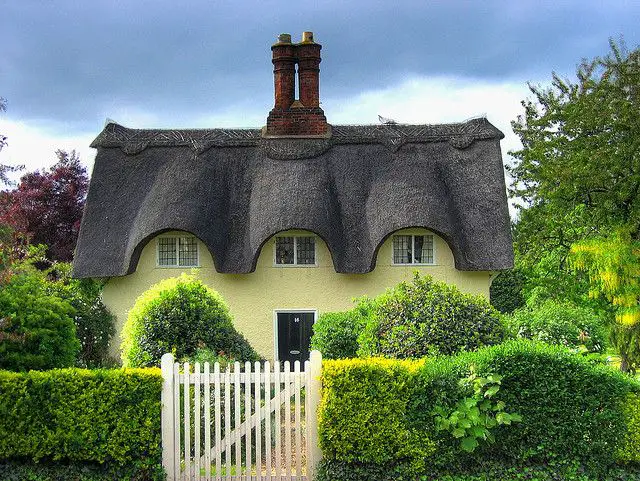
What Makes a Chocolate Box Cottage?
There are a number of distinct qualities that make English chocolate box cottages what they are. The most instantly recognizable features are:
The Thatched Roof
An English chocolate box cottage has a thatched roof. Thatch roofing is an old roofing method using materials like straw, reed, rushes, etc, producing not only excellent insulation, but also a gorgeously rustic aesthetic.
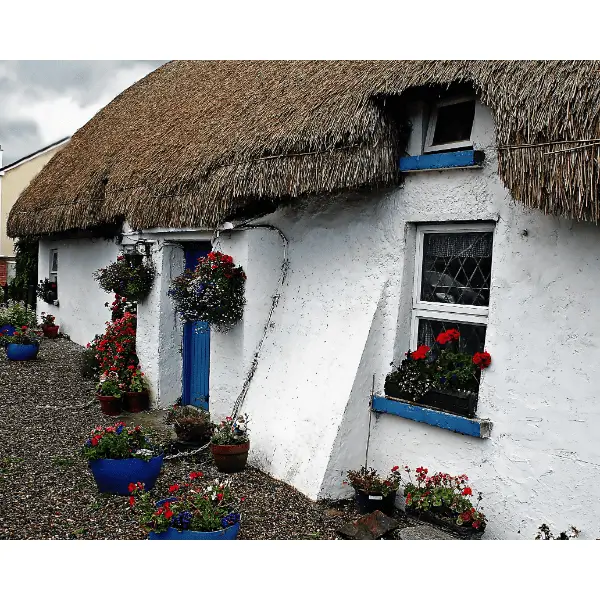
Leadwork Windows
The design of an English chocolate box cottages always includes decorative windows, with stylish leadwork and window seats where anyone could get lost in a daydream. Typically, wooden shutters frame the window that are often painted in soft pastel shades.
Brace and Ledge Doors
Made from vertical planks with a central ledge to hold them in place, Brace and Ledge Doors then have black iron braces fixed on them, top and bottom.
Cast iron black handles and door knockers complete the chocolate box look.
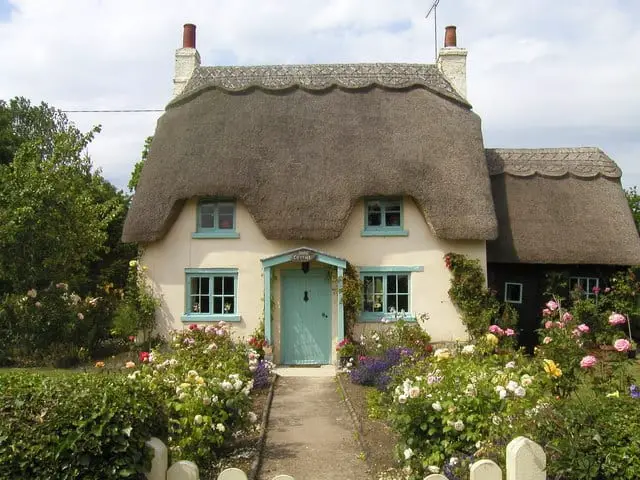
Chimney and Inglenook Fireplace
Open inglenook fireplaces are a staple in chocolate box cottage homes. Nothing quite speaks of a rural idyll than a working fireplace. Chimneys are a necessity, not just an aesthetic in such cases.
An English Country Garden
You won’t see a chocolate box cottage that isn’t surrounded by a host of lovely fragrant flowers. Roses are a must have, but you’ll also usually find:
- Wisteria winding up walls: the sweet scent of wisteria is second only to its gorgeous blooms.
- Peonies: similar in looks to the Rose and sometimes even mistaken for it, peonies make for big, fluffy, fragrant blossoms.
- Fruit trees: the most common types of fruit trees that grow in the UK – apples, apricots, peaches, pears, and plums – are essential features of chocolate box cottage gardens.
You’ll also find mixed beds full of colour, height, and texture packed full of these wonderful flowers:
- Lavender
- Honeysuckle
- Cosmos
- Geraniums
- Delphiniums
- Aquilegia
- Phlox
- Campanula
- Foxglove
- Catmint
- Rambling Roses
What is a Chocolate Box House?
A chocolate box house in England is the same as a chocolate box cottage, the terms are used interchangeably but they are identical and share the same characteristic.
Chocolate Box House Meaning
A “chocolate box house” looks just like one of the houses in the charming scenes pictured on the front of Cadbury Milk Tray chocolate boxes throughout the 1950s and 1960s. Which created the term – “chocolate box house”

Why are Thatched Houses Called Chocolate Boxes?
The term “chocolate box” has been used to describe thatched cottages and houses since the 1920s. This is a result of their picturesque and idyllic appearance similar to the images found on vintage chocolate boxes.
The unique texture and warm colour of the thatch, combined with the quaint architecture of these houses, creates a charming and cozy look that is often associated with rustic or countryside living.
What is Chocolate Box Architecture?
Chocolate box architecture simply refers to how the cottage is built. The chocolate box cottage style is typically characterized by a small and cozy design, with an emphasis on charm and character.
The architecture often features small windows with diamond-shaped panes, a low, sloping roof, and a door that is slightly off-center.
The exterior is often painted in soft pastel shades, and there may be a small garden with a picket fence surrounding the property.
What is a Chocolate Box Villages
England has been blessed with numerous unspoiled places of outstanding natural beauty in which lie picturesque villages full of houses with the signature thatched roofs, chimneys, and lush flowers that characterise them as chocolate box cottages.
However, villages with mediaeval half-timbered houses and beautiful Norman churches and duckponds have also become synonymous with the phrase “chocolate box village”: therefore, a chocolate box village does not have to contain cottage box cottages to qualify as being “chocolate box”.
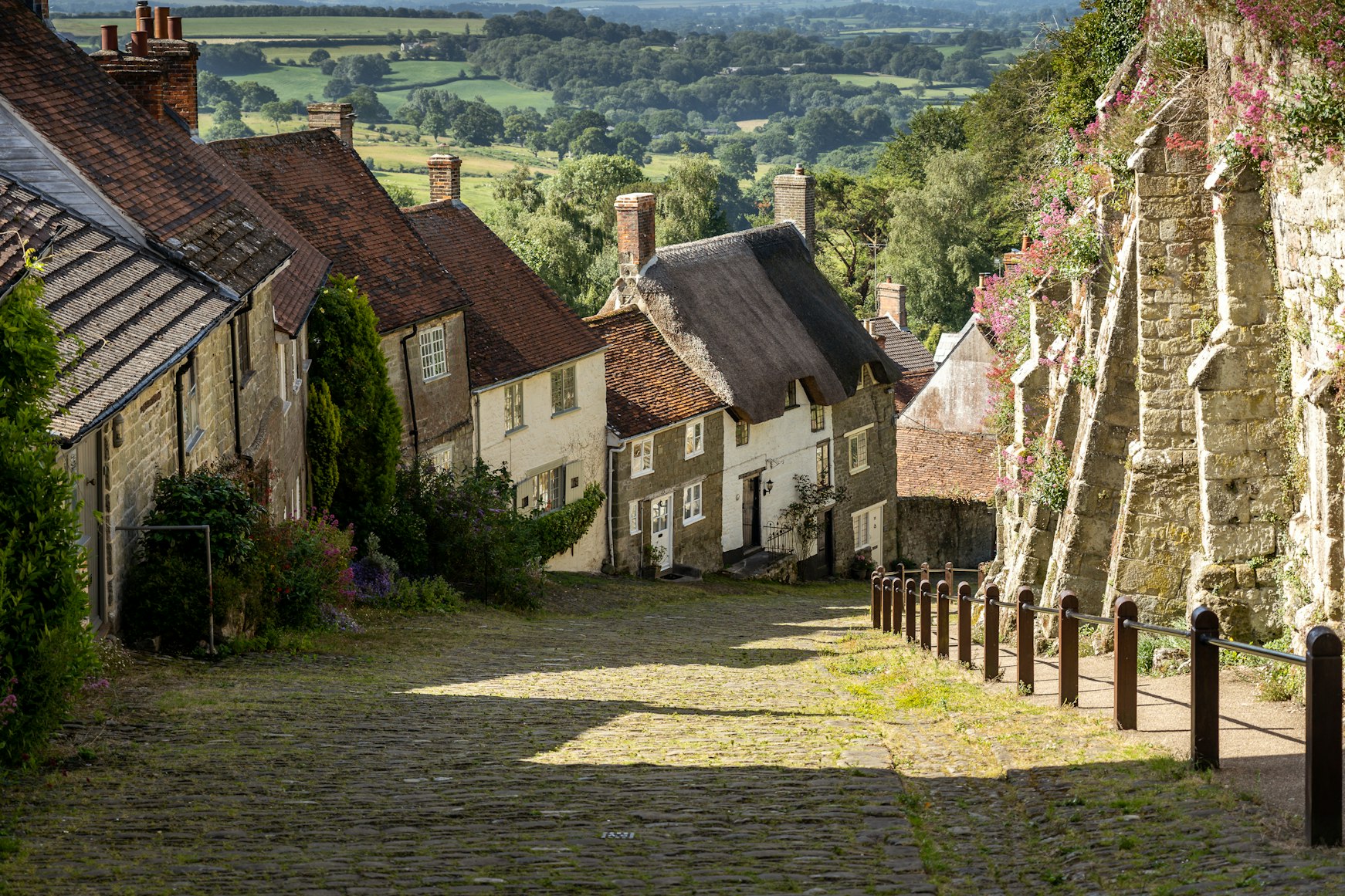
Today, these villages are one of the major tourist attractions of the UK, visited by not just homesick expatriates, but serious artists, and daydreaming novelists.
Which Villages in England have The Best Chocolate Box Cottages?
Here are just a few of the most popular chocolate box villages in the UK:
Shere
Shere in Surrey has beautiful cottages, manor houses, churches, and pubs. Plus, it boasts movie credits, being the setting of famous movies like Four Weddings and a Funeral, Bridget Jones – the Edge of Reason, and A Matter of Life and Death.
Shere is located 35 miles southwest of Central London by car. By train, it’s a one-hour train ride from Waterloo to Gomshall with a change at Guildford.
Lavenham
Lavenham in Suffolk is considered one of England’s best-preserved mediaeval villages and has the interesting historical fact of being one of the boomtowns in the 15th century that processed wool and sent it to the continent. It thus became a very wealthy place and its houses reflect it.
Its brightly-coloured half-timbered houses are widely popular with visitors from all over the world.
Lavenham also has movie credits. The famous De Vere House there starred in Harry Potter and the Deathly Hallows.
Lavenham is located 76 miles from Central London by car. By train, it’s a one hour and 30-minute ride from Liverpool Street to the nearest station, Sudbury.
Brockenhurst
Besides its chocolate box cottages, this town in Hampshire holds many other attractions. Notably, the animals.
The New Forest is infamous for its ponies and wild boar; lucky visitors have reported catching glimpses of a wild pony or two, deer, cows, and grazing donkeys.
If you don’t catch sight of a boar, there is always the local: ‘The Pig’, where you can also get a spot of lunch.
Another side attraction is Brockenhurst river beach; a small, breathtaking beach on the Lymington River.
Brockenhurst is located 90 miles from London by car. Alternatively, it’s a 90-minute train ride from Waterloo.
Great Missenden
This chocolate box village in Buckinghamshire is on the top of the list for many literature enthusiasts, being the home and workplace of Roald Dahl seventy years ago.
Great Missenden has an easy charm that made it a major stop for coaches even in the late Middle Ages.
And even though it can also claim on-screen credit thanks to ITV’s Midsomer Murders, Great Missenden is a perfectly safe place to explore.
Great Missenden is located 38 miles away from Central London by car. By train, it’s a 45-minute ride from Marylebone.
Chocolate Box Villages Near London
Alfriston
Nestling in the South Downs in East Sussex, Alfriston boasts many beautiful attractions along with its timbered houses: Clergy House, St. Andrew’s church, and Cuckmere River valley are just a few examples.
In fact, Alfriston’s allure was immortalized in the classic hymn, Morning Has Broken.
The village is located 80 miles from Central London by car. Alternatively, it’s a one hour fifteen minutes train ride from London to either Polegate or Lewes.

British Chocolate Box Cottages and Villages
Nothing quite signifies British culture and history like a chocolate box cottage. They have been a part of not just English history but art, popular culture, and entertainment for a very long time.
And now you know why. With such beauty promised, it’s no wonder that thousands visit chocolate box cottages in English chocolate box villages every year.
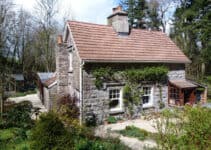
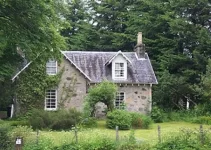
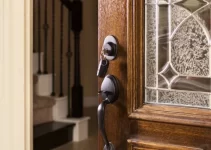
No Responses